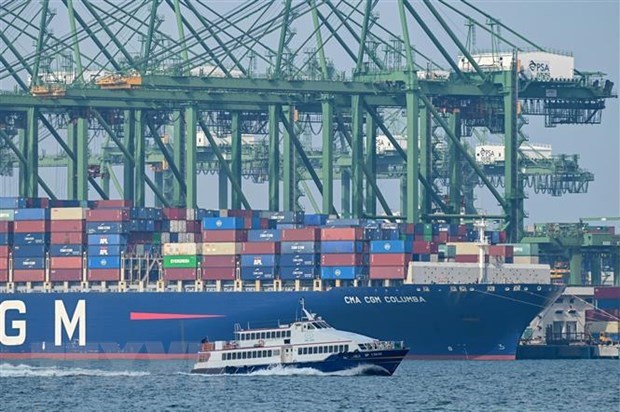ASEAN+3 region to see 4.3% growth this year: AMRO
 Container ships are seen at the Pasir Panjang terminal of the port of Singapore . (Photo: AFP)
Container ships are seen at the Pasir Panjang terminal of the port of Singapore . (Photo: AFP)Hanoi (VNA) - The ASEAN+3 Macroeconomic Research Office (AMRO) forecasts a 4.3% growth for the ASEAN+3 (Association of Southeast Asian Nations plus China, Japan, and the Republic of Korea) region this year, slightly lower than its previous forecast.
In a quarterly report published on July 5, AMRO said inflation for the region is projected to be 5.2%, up by 1.7 percentage points from April. GDP growth is expected to surge to 4.9% in 2023 and inflation is forecast at 2.8%.
According to Khor Hoe Ee, AMRO chief economist, the prolonged conflict in Ukraine and persistent inflation in the United States have posed challenges for policymakers as they must balance between maintaining growth momentum and containing inflationary pressures.
The recent COVID-19 outbreak in China’s Shanghai city has resulted in a disruption to production and supply in the region, leading to a decrease in this year’s growth for China and the region.
However, AMRO notes that many ASEAN+3 economies are moving to treat COVID-19 as an endemic disease. Further easing of travel restrictions will help boost domestic demand, therefore, economic prospect for the ASEAN region, is expected to remain strong this year and next year.
Meanwhile, the latest ASEAN Economic Integration Brief (AEIB) said ASEAN economies are expected to grow by 4.9% this year and 5.2% in 2023 amid a higher vaccination rate, but challenges remain.
The report said the effective rollout of vaccination programmes enabled ASEAN member states to reopen, which sped up economic activities and supported recovery in the job market.
The ASEAN Integration Monitoring Directorate of the ASEAN Secretariat also highlighted that the full dose vaccination rate hit 65.9% of the population, while 25.2% had received booster shots as of May 2022.
The report noted that ASEAN member states are expected to fully reopen by the second half of this year. Optimism continues into 2022, with manufacturing index continuing to gain momentum despite risks of COVID-19 variants and spikes in commodity prices in the first half of the year, it said./.












